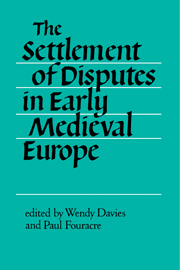Book contents
- Frontmatter
- Contents
- List of figures
- Preface
- Abbreviations
- Introduction
- 1 Disputes in late fifth- and sixth-century Gaul: some problems
- 2 ‘Placita’ and the settlement of disputes in later Merovingian Francia
- 3 Dispute settlement in Carolingian West Francia
- 4 People and places in dispute in ninth-century Brittany
- 5 Visigothic law and regional custom in disputes in early medieval Spain
- 6 Land disputes and their social framework in Lombard–Carolingian Italy, 700–900
- 7 Dispute settlement in the Byzantine provinces in the tenth century
- 8 Charters, law and the settlement of disputes in Anglo-Saxon England
- 9 Dispute settlement in medieval Ireland: a preliminary inquiry
- 10 An early modern postscript: the Sandlaw dispute, 1546
- Conclusion
- Appendix texts of the documents discussed
- Glossary
- List of works cited
- Index
4 - People and places in dispute in ninth-century Brittany
Published online by Cambridge University Press: 11 January 2010
- Frontmatter
- Contents
- List of figures
- Preface
- Abbreviations
- Introduction
- 1 Disputes in late fifth- and sixth-century Gaul: some problems
- 2 ‘Placita’ and the settlement of disputes in later Merovingian Francia
- 3 Dispute settlement in Carolingian West Francia
- 4 People and places in dispute in ninth-century Brittany
- 5 Visigothic law and regional custom in disputes in early medieval Spain
- 6 Land disputes and their social framework in Lombard–Carolingian Italy, 700–900
- 7 Dispute settlement in the Byzantine provinces in the tenth century
- 8 Charters, law and the settlement of disputes in Anglo-Saxon England
- 9 Dispute settlement in medieval Ireland: a preliminary inquiry
- 10 An early modern postscript: the Sandlaw dispute, 1546
- Conclusion
- Appendix texts of the documents discussed
- Glossary
- List of works cited
- Index
Summary
The records of dispute and dispute settlement from northern Europe, although few by comparison with those of the South, include an unusually large set of useful material in the collection of charters relating to the monastery of Redon in eastern Brittany. Redon, on the River Vilaine, 65 km south-west of Rennes, was founded in 832 and soon gained the patronage of the Carolingian emperor Louis and of his representative in Brittany, Nominoe. It received many small grants of property in its neighbourhood in the decades following the foundation, and records of the grants, along with other documents, were copied in the eleventh century into the Cartulaire de Redon.
This cartulary contains 283 charters of the ninth and early tenth centuries; and a further sixty-two charters, which may not have been included in the medieval cartulary, are known from early modern transcripts. Three-quarters of these charters relate to the forty years following the monastery's foundation and constitute – for the ninth century – an unusually large number of documents to deal with a small region. The lands with which the charters are concerned lie between Rennes, Nantes and Vannes, but most of the properties fall within 40 km of Redon itself (fig. 2). Many of the grants were of small areas (in the order of 10–25 hectares), and the donors, vendors and plaintiffs of the records were peasant farmers: most of the individuals mentioned worked the land themselves and confined their business to their own village communities. The collection, then, is largely a collection of private, rather than government, acts and is particularly valuable in allowing insight into the workings and relationships of peasant communities.
- Type
- Chapter
- Information
- The Settlement of Disputes in Early Medieval Europe , pp. 65 - 84Publisher: Cambridge University PressPrint publication year: 1986
- 4
- Cited by



